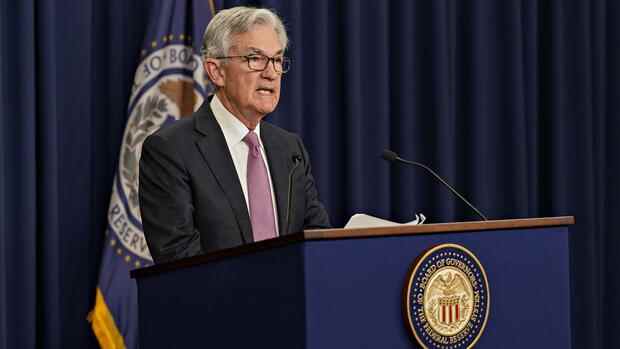new York The US Federal Reserve (Fed) is speeding up its fight against inflation. It raised the key interest rate by 0.5 percentage points on Wednesday, to a range of 0.75 to 1.0 percent.
It is the first hike of this magnitude since 2000 and the second rate hike in a row. In March, the Fed initiated the turnaround in interest rates with an increase of 0.25 percentage points.
Fed Chairman Jerome Powell was under pressure to act in view of the rapid price increases. Inflation in the US was last at 8.5 percent, with low earners suffering the most. A “dangerous wage-price spiral” had recently emerged on the labor market, as the independent capital market consultant Ed Yardeni pointed out. That requires a much more aggressive approach.
“We pay very close attention to inflation risks,” the Fed said (read the original statement here). Powell knows he must act. “I want to address the American people directly,” he said at the beginning of Wednesday’s press conference, which was held in Washington for the first time since the pandemic began with reporters on the ground. “Inflation is far too high and we recognize that this has serious consequences, especially for those who cannot easily meet the higher costs of food, housing and petrol in particular.”
It is therefore “essential” to bring inflation under control. The overall goal is to bring price increases back to the target of two percent.
The Fed also published details of the planned reduction in total assets. It no longer wants to completely replace expiring bonds from its portfolio. First of all, the balance sheet total is to be reduced by 47.5 billion dollars, starting in June. From September, mining is expected to be $95 billion a month. The balance sheet had swelled to around nine trillion dollars in the wake of the pandemic – a new record.
Overall, however, Powell was less aggressive than many economists had anticipated. Investors on Wall Street therefore took heart: the broad S&P 500 rose by around 2.5 percent until just before the close of trading in New York. The leading index Dow Jones climbed by 2.7 percent. The Nasdaq technology exchange even rose by a good three percent. By contrast, yields on ten-year government bonds fell slightly.
When it came to reducing total assets in particular, the Fed was “slightly slower and more cautious than many had expected,” pointed out Erik Norland, chief economist at CME Group. Powell clarified that it was very difficult to gauge exactly how the phase-out of US Treasuries and mortgage-backed securities would affect markets. The Fed therefore wants to run the program largely on autopilot and continue to exert a significant influence on monetary policy with the interest rate hikes.
But here, too, Powell allowed a little more leeway. For the next two Fed meetings, investors should expect further hikes of 0.5 percentage points each. However, there is nothing more to fear for the time being, he reassured investors. “We are not currently discussing an increase of 0.75 percentage points,” he clarified. This had been brought into play by some central bankers in the past few weeks.
The question now is whether this rate is sufficient to get inflation under control. This is a hotly debated topic on Wall Street. Former Fed governor Robert Heller assumes that the central bank still has to become significantly more aggressive. Only if the key interest rate is higher than the inflation rate could monetary policymakers get the price increases under control, he told the CNBC broadcaster. A recession is therefore inevitable.
Yardeni, on the other hand, believes that the economy would be sufficiently slowed down with a base rate of 2.5 to 3 percent. “I think a soft landing is definitely possible,” he clarified. This means a scenario in which the economy cools down enough without causing a recession. “There’s too much negativity in the market right now,” Yardeni said.
Fed Chair Powell hopes for a “reasonably soft” landing
Powell said Wednesday he was confident that a “reasonably soft” landing was possible. The labor market is currently very strong with an unemployment rate of 3.5 percent. “For every unemployed person there are 1.9 vacancies,” such a good situation has not existed for a long time.
Ideally, more people would be pushing back into the workforce, and job vacancies would fall without the unemployment rate having to rise, Powell explained. “Then wages would fall and with them the inflationary pressure.”
However, the Fed chair also warned that there were many risks and developments in Ukraine were somewhat “out of our control”.
Investors shouldn’t get too excited, however, warned David Zervos, market strategist at US investment bank Jeffries. “Powell wasn’t quite as aggressive today as we expected. But it could well be that the Fed will have to readjust again in the summer if it becomes apparent that they are not getting inflation under control.” He therefore advises caution when buying shares and other risky assets.
Yellen warns of the consequences of inflation
US Treasury Secretary Janet Yellen stressed the strength of the US economy ahead of Wednesday’s Fed meeting, even though economic growth slowed in the first quarter. However, she also worries about high inflation, she admitted. “We face great uncertainties. The risks on a global level are very high.”
The US economy is particularly at risk from the consequences of the Ukraine war. If Europe does without energy from Russia, this could also lead to significantly higher prices for oil, gas and other raw materials in the USA. The central bankers, who unanimously decided to raise interest rates, are also concerned about developments in China. The new pandemic-related lockdowns “are likely to further accelerate supply chain problems.”
More: “We will do what is necessary” – ECB Director Schnabel announces a turnaround in interest rates

